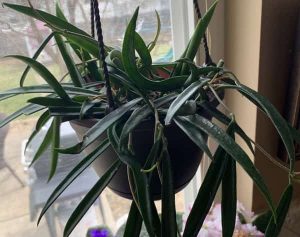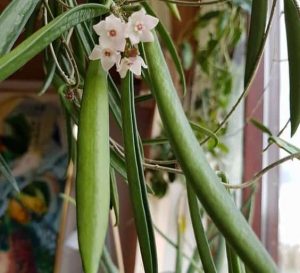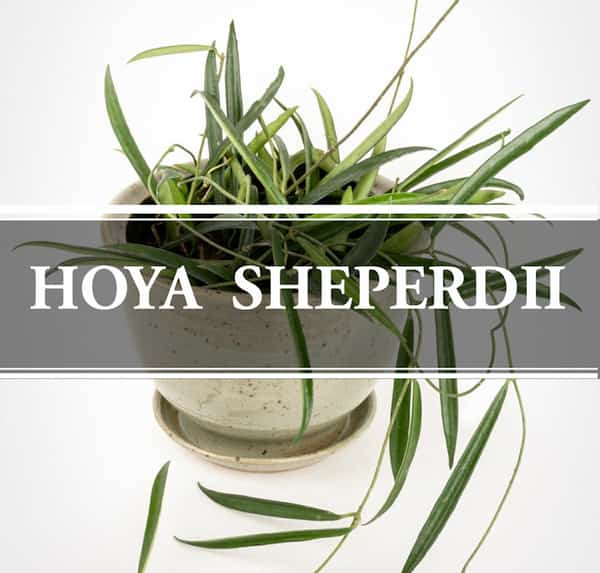Who wouldn’t like an easy-to-care Hoya vine with uniquely long leaves growing on cascading pendulous vines? Hoyas make popular and attractive houseplants. We have discussed a few Hoyas up till now. We are going to introduce one of the most beautiful and easy-to-care Hoyas, the Hoya shepherdii.
The plant grows dark-green, elongated leaves with shiny and waxy leaves. These leaves grow on long and thin cylindrical stems. The plant is an excellent choice to form hanging baskets in which the stems hang down gracefully with the weight of the leaves. Moreover, clusters of white to light pink typical Hoya flowers grow on the plant to enhance its beauty. Let us know more about the H.shepherdii plant along with its care and propagation.
Hoya Shepherdii Classification
Family: Apocynaceae.
Genus: Hoya.
Species: Hoya longifolia.
Genus Hoya
Hoya is a unique genus with still a large number of unidentified species. New species keep on getting added to the current list of about 600 to 700 members. This genus of evergreen perennial Asian natives was named by botanist R.Brown in tribute to his friend T.Hoy. These hoyas tend to climb on the nearby plants or support with the help of their adventitious roots. The growth habit may be terrestrial or epiphytic.
These plants are popular for thick succulent leaves and characteristic bunches of small flowers. The waxy foliage makes these plants associated with a number of common names like;
- Wax plant.
- Wax Vine.
- W. Flowers.
Hoya Shepherdii Other Names
- The accepted botanical name of the Shepherdii is the ‘Hoya longifolia’. While the Shperdii is actually a synonym.
- The characteristic cascading foliage gives the common name, String Bean Hoya.
Hoya Shepherdii Plant Features

- Each vine may grow up to 6 feet long.
- This plant doesn’t climb much and usually lives draping down the walls of the pot.
Leaves
- Each mature leaf is around 5 to 10 inches long and lesser than 2 inches wide.
Flower
- The plant produces tiny bouquets of cream to baby pink star-shaped flowers.
- Each bouquet is around 4 to 5 cm in size with 8 to 15 leaves of 0.4 cm.
- The flowers are showy and fragrant.
Season
The plant blooms in spring. New flowers grow on the same stalks after old flowers finish blooming.
Toxicity
These plants are usually toxic in nature. The milky white inner fluid is responsible for the toxicity. Thus, it is always safe to keep kids and pets away from the plant.
Hoya Shepherdii Care

Water Requirement
The plant owns a prominent drought tolerance. It can withstand a few days of neglect. However, to maintain the foliage you need to follow the proper watering schedule. You need to water the plant when the upper 2 inches of the soil get dry. An estimated frequency is to water about twice or thrice in summer. However, once or twice a week is enough for the colder days.
Make sure you avoid keeping the soil wet or soggy. The reason being overwatering may lead to plant issues like root rot.
Sunlight Requirement
Hoyas are adapted to bright indirect sunlight and dappled shade. Direct exposure to sunlight especially in peak hours is harmful to the delicate foliage.
Temperature Requirement
Hoyas strive best in 30 to 40 °F. Moreover, the longifolia are not adapted to cold temperatures. Thus, you need to transfer the plant to a warmer area, as soon as the fall arrives.
Humidity Requirement
About 70% of the moisture is ideal for the humidity-loving String Bean Hoya Vine. On dry days, consider grouping the plants, introducing a humidifier in surroundings, or a pebble-water tray under the pot.
Soil Requirement
Light and well-drained with plenty of aeration is ideal for this plant. An equal mixture of peat, orchid mix, and perlite shows good results for the majority of Hoyas.
Fertilizer Requirements
Hoyas don’t do heavy eating. Howbeit, some added nutrition will show good effects on the foliage. People have tried domestically available dilute fish emulsion or compost tea once a month in spring and summer. Alternatively, you can use commonly available house plant mix according to the instructions on the pack. You don’t need to provide any extra nutrition in fall and winter.
Pot Requirements
The plants need to be root bound with good drainage and quick drying. An ideal pot will be a small-sized terracotta plant with drainage holes.
Pruning Requirements
Vines need regular pruning. Thus, remove the unhealthy leaves preferable from the lower sides. This will enhance the health and appearance of this waxy vine. To be on the safe side, it would be great to use precautionary measures like using a pair of gloves.
Hoya Shepherdii Propagation

- Herbaceous and Woody Stem-Cutting.
- Leaf-Cutting.
Season
The plant grows actively in spring and summer. This is the ideal time to propagate.
Propagation By Stem-Cuttings
- Cut a 5 to 8 inches cutting from the growing end of the stem. Keep at least 2 to 6 leaves on the upper side of the stem.
- Now, plant the stem cutting at least 4inches deep in a jar of water or moist growing medium. Make sure the nodes are under the water/soil.
- Place the plant in a warm and moist place with medium indirect sunlight. In the case of water propagation, keep changing the water regularly preventing it from getting murky.
- Root development will start after the 3 weeks. This will be followed by the shoot development after the 4th week.
TimeLine
Let us get an idea about the growth pattern and initial requirements of the plant.
Day 1 to Day 30: Keep the plant warm, humid, and in medium indirect light. Mist the soil mildly about three times a week. Avoid overwatering. Root and shoot initiation will be seen by the end of the first month.
Day 30 to Day 60: The root system will be quite developed at this stage. You can now convert the water-propagated ones to the soil. Secondly, you can reduce the water frequency while increasing the quantity. However, over-watering always needs to be avoided.
Day 60 to Day 90: You can finally follow the Hoya shepherdii Care stated above. Time to enjoy the beautiful development of the H. longifolia vine.
Related Post:
Summary
Hoya shepherdii or Hoya longifolia is an evergreen perennial vine. The lush green, elongated waxy leaves growing on long cascading stems make them look pretty attractive. On warm days, you can see the plant beautified with pale pink or off-white tiny fragrant flowers growing in tiny clusters.
The plant is one of the easiest to grow Hoyas. Additionally, they need a warm, humid place with indirect light and watering after the drying of the upper layer. These plants are perfect for hanging baskets. In addition, keep your kids and pets away from the toxic Shepherdii Vine.

